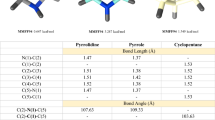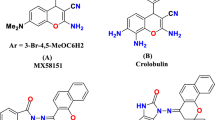Abstract
The versatile synthon E-methyl 2-(2-(1,3-dioxo-1-arylpropan-2-ylidene) hydrazinyl) benzoate has a potent cytotoxic activity, which was screened in vitro for anticancer activity against human hepatocellular carcinoma cell (HCC) line. The results show a higher anticancer efficacy and higher selectivity index (SI) on HCC versus doxorubicin that warrants further studies in both animals and humans; this work has been patented.



Similar content being viewed by others
References
Akamatsu M (2011) Importance of physicochemical properties for the design of new pesticides. J Agric Food Chem 59:2909–2917
Alves RC, Alves D, Guz B et al. (2011) Advanced hepatocellular carcinoma. Review of targeted molecular drugs. Ann Hepatol 10:21–27
Al-Zaydi KM, Borik RM (2007) Microwave assisted condensation reactions of 2-aryl hydrazonopropanals with nucleophilic reagents and dimethyl acetylenedicarboxylate. Molecules 12:2061–2079
Al-Zaydi KM, Saleh TS, Bin Hadda T (2019) Potent cytotoxic agents against human hepatocellular carcinoma cell line based 2-aryl hydrazonopropanals pharmacophore. US Patent 10,280, 134B1
Arnott JA, Kumar R, Planey SL (2013) Lipophilicity indices for drug Development. J Appl Biopharm Pharcokin 1:31–36
Arnott JA, Planey SL (2012) The influence of lipophilicity in drug discovery and design. Expert Opin Drug Discov 7:863–875
Badisa RB, Darling-Reed SF, Joseph P, Cooperwood JS, Latinwo LM (2009) Selective cytotoxic activities of two novel synthetic drugs on human breast carcinoma MCF7 cells. Anticancer Res 29:2993–2996
Bassyouni FA, Abu-Baker SM, Mahmoud K, Moharam M, El-Nakkady SS, Abdel-Rehim M (2014) Synthesis and biological evaluation of some new triazolo[1,5-a]quinoline derivatives as anticancer and antimicrobial agents. RSC Adv 4(46):24131–24141
Blum HE (2005) Hepatocellular carcinoma: therapy and prevention. World J Gastroenterol 11:7391–7400
Bosch FX, Ribes J, Díaz M, Cléries R (2004) Primary liver cancer: worldwide incidence and trends. Gastroenterology 27:5–16
Brigger I, Dubernet C, Couvreur P (2002) Nanoparticles in cancer therapy and diagnosis. Adv Drug Deliv Rev 54:631–651
Chen KF, Chen HL, Tai WT, Feng WC, Hsu CH, Chen PJ, Cheng AL (2011) Activation of phosphatidylinositol 3-kinase/Akt signaling pathway mediates acquired resistance to sorafenib in hepatocellular carcinoma cells. J Pharm Exp Ther 337:155–161
Curatolo W (1998) Physical chemical properties of oral drug candidates in the discovery and exploratory drug development settings. Pharm Sci Technol Today 19:387–393
El-Menshawi BS, Fayad W, Mahmoud K, El-Hallouty SM, El- Manawaty M, Olofsson MH, Linder S (2010) Screening of natural products for therapeutic activity against solid tumors. Indian J Exp Biol 48:258–264
Gleeson MP (2008) Generation of a set of simple, interpretable ADMET rules of thumb. J Med Chem 51:817–834
Hung CS, Lin SF, Liu HH et al. (2012) Survivin-mediated therapeutic efficacy of gemcitabine through glucose-regulated protein 78 in hepatocellular carcinoma. Ann Surg Oncol 19:2744–2752
Kaseb AO, Shindoh J, Patt YZ et al. (2013) Modified cisplatin/interferon alpha-2b/doxorubicin/5-fluorouracil [PIAF] chemotherapy in patients with no hepatitis or cirrhosis is associated with improved response rate, resectability, and survival of initially unrespectable hepatocellular carcinoma. Cancer 119:3334–3342
Kearns EH, Di L (2008) Drug-like properties: concepts, structure design and methods. Elsevier, USA
Kellen JA (1993) The reversal of multidrug resistance in cancer (review). Anticancer Res 13:959–961
Kodama Y, Fumoto S, Nishi J et al. (2008) Absorption and distribution characteristics of 5-fluorouracil [5-FU] after an application to the liver surface in rats in order to reduce systemic side effects. Biol Pharm Bull 31:1049–1052
Li T, Dong ZR, Guo ZY et al. (2013) Aspirin enhances IFN-alpha-induced growth inhibition and apoptosis of hepatocellular carcinoma via JAK1/STAT1 pathway. Cancer Gene Ther 20:366–374
Lipinski CA, Lombardo F, Dominy BW, Feeney PJ (2001) Experimental and computational approaches to estimate solubility and permeability in drug discovery and development settings. Adv Drug Del Rev 46:3–26
Malik MA, Raza MK, Dar OA, Abid M, Wani MY, Al-Bogami AS, Hashmi AA (2019) Probing the antibacterial and anticancer potential of tryptamine based mixed ligand Schiff base Ruthenium (III) complexes. Bioorg Chem 87:773–782
Masriani M, Mustofa M, Jumina J, Sunarti S, Enawaty E (2014) Cytotoxic and pro-apoptotic activities of crude alkaloid from root of sengkubak (Pynarrhena cauliflora (Miers) Diels) in human breast cancer T47D cell line. Sch Acad J Biosci 2(5):336–340
Minotti G, Recalcati S, Mordente A et al. (1998) The secondary alcohol metabolite of doxorubicin irreversibly inactivates aconitase/iron regulatory protein-1 in cytosolic fractions from human myocardium. FASEB J 12:541–552
Miyamoto Y, Koh YH, Park YS et al. (2003) Oxidative stress caused by inactivation of glutathione peroxidase and adaptive responses. Biol Chem 384:567–574
Mosmann T (1983) Rapid colorimetric assays for cellular growth and survival: application to proliferation and cytotoxicity assays. J Immunol Methods 65:55–63
Rutman RJ, Cantarow A, Paschkis KE (1954) Studies in 2-acetylaminofluorene carcinogenesis. I. The intracellular distribution of nucleic acids and protein in rat liver. Cancer Res 14:111–114
Song DS, Bae SH, Song MJ et al. (2013) Hepatic arterial infusion chemotherapy in hepatocellular carcinoma with portal vein tumor thrombosis. World J Gastroenterol 19:4679–4688
Tapiero H, Mishal Z, Wioland M, Silber A, Fourcade A, Zwingelstein G (1986) Changes in biophysical parameters and in phospholipid composition associated with resistance to doxorubicin. Anticancer Res 6:649–652
Thabrew MI, Hughes RD, McFarlane IG (1997) Screening of hepatoprotective plant components using a HepG2 cell cytotoxicity assay. J Pharm Pharm 49:1132–1135
Trott O, Olson AJ (2010) AutoDock Vina: Improving the speed and accuracy of docking with a new scoring function, efficient optimization, and multithreading. J Comput Chem 31:455–461
Wang S, Kotamraju S, Konorev E et al. (2002) Activation of nuclear factor-kappaB during doxorubicin-induced apoptosis in endothelial cells and myocytes is pro-apoptotic: the role of hydrogen peroxide. Biochem J 367:729–740
Wani MY, Bhat AR, Azam A, Athar F (2013) Nitroimidazolyl hydrazones are better amoebicides than their cyclized 1, 3, 4-oxadiazoline analogues: in vitro studies and Lipophilic efficiency analysis. Eur J Med Chem 64:190–199
Whittaker S, Marais R, Zhu AX (2010) The role of signaling pathways in the development and treatment of hepatocellular carcinoma. Oncogene 29:4989–5005
Yang TS, Lin YC, Chen JS et al. (2014) Phase II study of gemcitabine Oncol Rev 8:246, 31
Acknowledgements
This project was funded by the Deanship of Scientific Research (DSR), King Abdulaziz University, Jeddah, under grant No. (P-0140-363-0436). The authors, therefore, acknowledged with thanks DSR technical and financial support.
Author information
Authors and Affiliations
Corresponding author
Ethics declarations
Conflict of interest
The authors declare that they have no conflict of interest.
Additional information
Publisher’s note Springer Nature remains neutral with regard to jurisdictional claims in published maps and institutional affiliations.
Rights and permissions
About this article
Cite this article
Alzaydi, K.M., Saleh, T.S. 2-Aryl hydrazonopropanal pharmacophores as potent cytotoxic agents against human hepatocellular carcinoma cell line. Med Chem Res 29, 199–205 (2020). https://doi.org/10.1007/s00044-019-02473-8
Received:
Accepted:
Published:
Issue Date:
DOI: https://doi.org/10.1007/s00044-019-02473-8




